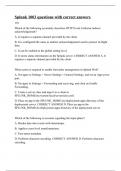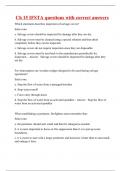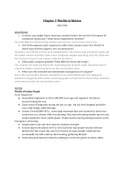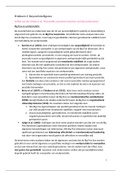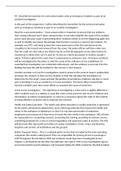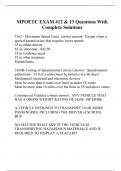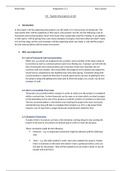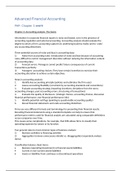Waves
Definitions:
1) Amplitude: A wave’s maximum displacement from its equilibrium position
2) Node: A position on a stationary wave where the displacement from midline is zero.
Distance between two successive nodes is half a wavelength.
3) Antinode: A position on a stationary wave where displacement from the midline is at
a maximum
4) EM waves: Transverse waves that have synchronised magnetic and electric
oscillations due to periodic changes in the magnetic or electric field. All EM waves
travel at the speed of light in vacuums.
5) Frequency: Number of waves passing a given point per unit time. Inverse of period.
6) Interference: The superposition of waves that occurs which is a result of two waves
meeting each other. For waves in phase → constructive interference (amplitudes add
up) and for waves out of phase → destructive interference (amplitudes cancel out).
7) Transverse waves: Waves that have particle oscillations perpendicular to the
direction of energy transfer. Consists of peaks and troughs. Shaking a slinky side by
side or up and down transverse.
8) Longitudinal waves: Waves that have particle oscillations parallel to the direction of
energy transfer. Consists of rarefactions and compressions. Cannot travel through
vacuums. Example: Pushing a slinky horizontally.
9) Stationary waves: A standing wave that does not transfer energy but does store
energy.
10) Progressive waves: Transfers energy without transferring material and is made up
of particles in a medium or field (like water particles in a water wave moving up and
down). Does not cause permanent displacement of the medium.
11) Phase: A measure of how far through a wave’s cycle a position on the wave is or the
position of a certain point on a wave cycle.
12) Wavelength: The distance between adjacent peaks or troughs in transverse waves,
or the distance between the start of one compression / rarefaction to the start of the
next compression / rarefaction. Or the distance between two consecutive locations
on a wave which are in phase.
13) Speed: Speed = wavelength x frequency
14) Path length: Distance travelled by the wave under investigation
15) Path difference: Difference in the distance travelled by the two waves in
investigation
Progressive waves:
- Transfers energy without transferring material and is made up of particles of a
medium or field (like water particles in a water wave moving up and down). Does not
cause permanent displacement of the medium.
- Phase:
● The position of a certain point on a wave cycle.
● Phase difference: How much a wave / particle lags behind another wave /
particle
● How to calculate phase difference:
, ○ Choose the two points on the wave in investigation. Work out the
horizontal distance between them and use: (distance / wavelength) x
360
● If two crests of two waves pass the same point or line at the same time, they
are completely in phase. If one crest of a wave and the trough of another
wave pass the same point at the same time, they are completely out of
phase. Both waves must have the same wavelength and frequency.
● Two adjacent crests on the same wave are completely in phase (360 degree
phase). A crest and the adjacent trough on the same wave are completely out
of phase (180 degree phase).
- Period: Time taken for one full oscillation (Period = 1/Frequency)
Stationary waves:
- Superposition: When two waves of the same frequency, wavelength and speed
travelling in opposite direction pass through each other, their displacements combine
resulting in a resultant displacement which is a vector sum of each wave’s
displacement. The type of superposition depends on the phase difference between
the two waves.
● Total destructive interference / superposition: When the two waves in
investigation are completely out of phase resulting in the amplitudes to cancel
out and result in a straight, horizontal line.
○ On a stationary wave, where the two waves are completely out of
phase, a node forms as a result of perfect destructive interference and
the amplitudes cancelling out.
● Constructive interference / superposition: When the two waves in
investigation are completely in phase resulting in the amplitudes to add up.
○ On a stationary wave, where the waves are completely in phase, an
antinode forms due to the result of perfect constructive interference.
The two amplitudes add up resulting in a maximum amplitude.
- A stationary wave is formed when two progressive waves travelling in opposite
directions with the same frequency, wavelength, and amplitude pass through each
other resulting in superpositions.
- Example: String fixed at one end and other attached to a vibration generator. When
the vibration is switched on, a wave is formed at the vibration generator end which
reflects on the other end resulting in superposition between the two waves to occur.
● Only happens because both waves have the same frequency, wavelength
and amplitude and same speed.
- Harmonics:
1) Lowest frequency (f) at which standing wave is formed is called first harmonic
(2 nodes, 1 antinode):
Definitions:
1) Amplitude: A wave’s maximum displacement from its equilibrium position
2) Node: A position on a stationary wave where the displacement from midline is zero.
Distance between two successive nodes is half a wavelength.
3) Antinode: A position on a stationary wave where displacement from the midline is at
a maximum
4) EM waves: Transverse waves that have synchronised magnetic and electric
oscillations due to periodic changes in the magnetic or electric field. All EM waves
travel at the speed of light in vacuums.
5) Frequency: Number of waves passing a given point per unit time. Inverse of period.
6) Interference: The superposition of waves that occurs which is a result of two waves
meeting each other. For waves in phase → constructive interference (amplitudes add
up) and for waves out of phase → destructive interference (amplitudes cancel out).
7) Transverse waves: Waves that have particle oscillations perpendicular to the
direction of energy transfer. Consists of peaks and troughs. Shaking a slinky side by
side or up and down transverse.
8) Longitudinal waves: Waves that have particle oscillations parallel to the direction of
energy transfer. Consists of rarefactions and compressions. Cannot travel through
vacuums. Example: Pushing a slinky horizontally.
9) Stationary waves: A standing wave that does not transfer energy but does store
energy.
10) Progressive waves: Transfers energy without transferring material and is made up
of particles in a medium or field (like water particles in a water wave moving up and
down). Does not cause permanent displacement of the medium.
11) Phase: A measure of how far through a wave’s cycle a position on the wave is or the
position of a certain point on a wave cycle.
12) Wavelength: The distance between adjacent peaks or troughs in transverse waves,
or the distance between the start of one compression / rarefaction to the start of the
next compression / rarefaction. Or the distance between two consecutive locations
on a wave which are in phase.
13) Speed: Speed = wavelength x frequency
14) Path length: Distance travelled by the wave under investigation
15) Path difference: Difference in the distance travelled by the two waves in
investigation
Progressive waves:
- Transfers energy without transferring material and is made up of particles of a
medium or field (like water particles in a water wave moving up and down). Does not
cause permanent displacement of the medium.
- Phase:
● The position of a certain point on a wave cycle.
● Phase difference: How much a wave / particle lags behind another wave /
particle
● How to calculate phase difference:
, ○ Choose the two points on the wave in investigation. Work out the
horizontal distance between them and use: (distance / wavelength) x
360
● If two crests of two waves pass the same point or line at the same time, they
are completely in phase. If one crest of a wave and the trough of another
wave pass the same point at the same time, they are completely out of
phase. Both waves must have the same wavelength and frequency.
● Two adjacent crests on the same wave are completely in phase (360 degree
phase). A crest and the adjacent trough on the same wave are completely out
of phase (180 degree phase).
- Period: Time taken for one full oscillation (Period = 1/Frequency)
Stationary waves:
- Superposition: When two waves of the same frequency, wavelength and speed
travelling in opposite direction pass through each other, their displacements combine
resulting in a resultant displacement which is a vector sum of each wave’s
displacement. The type of superposition depends on the phase difference between
the two waves.
● Total destructive interference / superposition: When the two waves in
investigation are completely out of phase resulting in the amplitudes to cancel
out and result in a straight, horizontal line.
○ On a stationary wave, where the two waves are completely out of
phase, a node forms as a result of perfect destructive interference and
the amplitudes cancelling out.
● Constructive interference / superposition: When the two waves in
investigation are completely in phase resulting in the amplitudes to add up.
○ On a stationary wave, where the waves are completely in phase, an
antinode forms due to the result of perfect constructive interference.
The two amplitudes add up resulting in a maximum amplitude.
- A stationary wave is formed when two progressive waves travelling in opposite
directions with the same frequency, wavelength, and amplitude pass through each
other resulting in superpositions.
- Example: String fixed at one end and other attached to a vibration generator. When
the vibration is switched on, a wave is formed at the vibration generator end which
reflects on the other end resulting in superposition between the two waves to occur.
● Only happens because both waves have the same frequency, wavelength
and amplitude and same speed.
- Harmonics:
1) Lowest frequency (f) at which standing wave is formed is called first harmonic
(2 nodes, 1 antinode):

